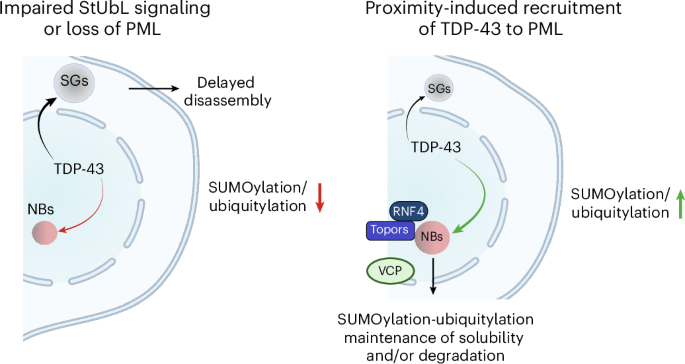2025-04-17 マックス・プランク研究所(MPI)
<関連情報>
- https://www.mpg.de/24545135/necroptosis-regulation-balancing-life-and-death
- https://www.cell.com/molecular-cell/fulltext/S1097-2765(25)00259-X
MLKLの活性にはスプライシングを制御する薬剤可能な分子内相互作用が必要 MLKL activity requires a splicing-regulated, druggable intramolecular interaction
Uris Ros ∙ Veronica Martinez-Osorio ∙ Pedro A. Valiente ∙ … ∙ Manolis Pasparakis ∙ Nieves Peltzer ∙ Ana J. García-Sáez
Molecular Cell Published:April 9, 2025
DOI:https://doi.org/10.1016/j.molcel.2025.03.015
Graphical abstract

Highlights
- Alternative splicing of C-terminal helix (Hc) creates an anti-necroptotic MLKL isoform
- Necroptosis sensitivity is regulated in human and mice by antagonist variants of MLKL
- Hc accommodation into a hydrophobic groove is a critical switch for MLKL activation
- The Hc/groove of MLKL can be targeted with small molecules to inhibit necroptosis
Summary
Necroptosis is an inflammatory form of regulated cell death implicated in a range of human pathologies, whose execution depends on the poorly understood pseudokinase mixed lineage kinase domain-like (MLKL). Here, we report that splicing-dependent insertion of a short amino acid sequence in the C-terminal α-helix (Hc) of MLKL abolishes cell killing activity and creates an anti-necroptotic isoform that counteracts cell death induced by the necroptosis-proficient protein in mice and humans. We show that interaction of Hc with a previously unrecognized hydrophobic groove is essential for necroptosis, which we exploited in a strategy to identify small molecules that inhibit MLKL and substantially ameliorate disease in murine models of necroptosis-driven dermatitis and abdominal aortic aneurysm. Thus, alternative splicing of microexons controls the ability of MLKL to undergo an intramolecular rearrangement essential for necroptosis with potential to guide the development of allosteric MLKL inhibitors for the treatment of human disease.


